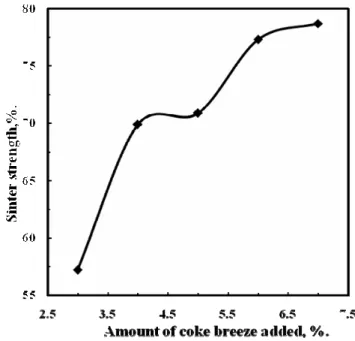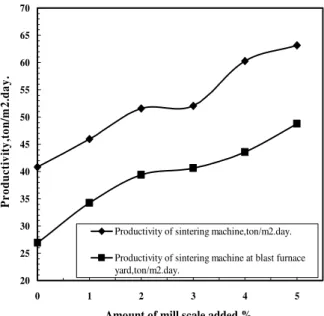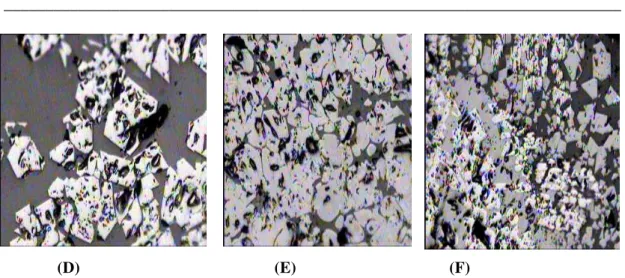_____________________________
*) Corresponding author: shalabimeh@yahoo.com
doi: 10.2298/SOS1101021E
UDK 622.785:620.784
Recycling of Mill Scale in Sintering Process
N. A. El-Hussiny, F. M. Mohamed, and M. E. H. Shalabi
*)Central Metallurgical Research and Development Institute (CMRDI),
Abstract:
This investigation deals with the effect of replacing some amount of Baharia high barite iron ore concentrate by mill scale waste which was characterized by high iron oxide content on the parameters of the sintering process., and investigation the effect of different amount of coke breeze added on sintering process parameters when using 5% mill scale waste with 95% iron ore concentrate.
The results of this work show that, replacement of iron ore concentrate with mill scale increases the amount of ready made sinter, sinter strength and productivity of the sinter machine and productivity at blast furnace yard. Also, the increase of coke breeze leads to an increase the ready made sinter and productivity of the sintering machine at blast furnace yard. The productivity of the sintering machine after 5% decreased slightly due to the decrease of vertical velocity.
Key words: Sintering process, Mill scale wastes, Coke breeze, Iron ore concentrate
1. Introduction
The recycling and utilization of iron-bearing by-products such as dust, scale and sludge have long been promoted in iron and steel-making industry due to their various benefits which are: (i) to reduce the depletion of the earth’s limited natural resources;(ii) to reduce pollution produced by discharging untreated waste; and (iii) to save energy indirectly.
The recycling of wastes generated in integrated steel plants currently can be realized by using one or two of five methods, which include sintering, cold bonded agglomeration, injection, direct reduction (DR) and smelting reduction. The choice of one of these methods depends on several important factors such as the environmental requirements, energy policy, company’s statues, company’s strategies in recycling, feasibility concerning economy and technology. [1-4]
Mill scale ( 3-7% of the total steel rolling) is a valuable secondary material due to its high iron content, low impurities and stable chemical composition. The mill scale from the rolling process and all iron bearing wastes generated at the iron and steel plant site are generally recycled into the sintering plant to produce high quality sinters.[5-6] The use of such sinter ( low silica and gangue materials ) leads to an decrease the blast-furnace fuel rate through reducing slag volume, permitting stable furnace operation as a result of improving high temperature properties, and reducing the cost of sub-raw materials [7-8].
The aim of this work is concerned with the following:
8 32 24 16 40
64 80
88 72 56 48
a = Hematite b = FeO(OH) a
b
a a
a b
a a
a a
a
a a
a a
a a
a a a a a
a a
2 - Theta
properties and quality.
2- Studying the effect of different amount of coke breeze on the parameter of the sintering mixture at optimum amount of mill scale replaced instead of iron ore.
2. Materials and methods
2.1. Raw materials
The raw materials used in this work are of iron ore concentrate from El-Baharia High Barite ore, mill scale, limestone, and coke breeze. The chemical composition of Baharia iron ore concentrate are: 50.82% of Fetotal , 9.14% of SiO2 , 1.9 % of CaO , 3.83% of MnO = and 2.06% of Al2O3 . The main component of mill scale are: 68%of Fetotal, 10.14%of FeO, 85.7% of Fe2O3 and 1% of SiO2. The main components of coke breeze are, 2.24% of Fe total, 4.55% of SiO2, 0.73% of CaO, 2.2%of Al2O3 and 0.082%of MgO . The sieve analysis of raw materials is shown in Tab. I.
Tab. I. Sieve analysis of the raw materials
Size, mm Iron Ore Limestone Mill
scale
Coke breeze
+8 0 0 0.36 0
-8 + 6 0 0 0.56 0
-6 + 4 0 0 3.8 0
-4 + 2 4.14 31.35 25.8 34.54
-2 + 0.5 43.64 20.94 31.18 22.9
-0.5 52.3 46.9 38.47 41.1
X- Ray analysis of iron ore and mill scale are shown in Figs. 1 and 2, from which it is clear that the components of the former are Hematite Fe2O3 and limonite, whereas the components of mill scale are Hematite Fe2O3, Magnetite Fe3O4, Wustite FeO and Silica SiO2..
Fig. 2: X-ray analysis of mill scale
Fig. 2. X-ray analysis of mill scale
2.2. Sintering Apparatus and Sintering Procedure
Sintering experiments were conducted in a laboratory down draft sinter pot (its diameter and height were 125 and 340 mm respectively, with capacity 5 kg). Air flow was provided by two fans in series which were capable of producing a suction pressure in excess of 12 kPa. The represented iron ore with mill scale, limestone, 30% of the charge sinter return, coke breeze(1-3mm) 6% , (the amount of coke breeze as reducing agent from the total dry charge used in sintering plant in Egyptian Iron and Steel Company) were blended together and then water (12% of the charge) was added through mixing the raw materials. The sinter charge basicity (CaO of the iron ore, mill scale, coke breeze and limestone / SiO2 of the iron ore, mill scale, coke breeze and limestone) = 1, was kept constant throughout all experiments of the influence of the replaced mill scale instead of iron ore .
The green charge was loaded over the sinter bed layer (0.5 Kg sinter + 10 mm). The green raw mix was ignited with a gas flame for a period 1.5 min. The ignition was done under suction pressure of 5.88 KPa, while the sintering process was done under suction pressure 11.76 KPa. The sintering time was determined by the time elapsed from the start of ignition until the exhaust gas temperature reached the maximum value. At the end of the sintering experiment, the produced sinter was dropped on to a steel plate laid on concrete and then the sinter cake was screened over a +7 mm sieve, to determine the productivity of the sintering machine (P), as shown in eq. 1.
P = 14.4 K ρ V ton/m2day (1) Where:
K is the percentage of ready made sinter from the charge.
ρ is bulk density of the charge, ton/m3.
V is vertical velocity of sintering machine (V = H/T) m/min. H is the height of the charge in sinter pot.
T is the time of sintering, min.
After that sinter cake above 7 mm was dropped four times from a height of 2 m (shatter test, (sinter strength) and screened over a 7 mm sieve. Sinter strength (Ss) as
2 0 3 0 4 0 5 0 6 0 7 0 8 0
b a
d
b a
a + b
c c
b
a a
b
c b
a
c c a - F e2O 3
b - F e3O 4
c - F e O
d - S iO2
illustrated in eq. 2, was calculated as the percentage of sinter (above 7 mm) after shatter test, related to the ready made sinter strength [9].
Ss % = W1/W2 * 100 (2)
Where Ss% is the sinter strength, W1, W2 represent the weight of sinter (above 7 mm) after and before shatter test respectively.
The productivity of the sinter machine at blast furnace yard (PB.F) was calculated according to the following equation [9]:
PB.F = p * Ss (3) Where PB.F is the productivity of the sinter machine at blast furnace yard, expressed in ton/m2 per day, P is the productivity of sintering machine, also expressed in ton/m2 per day and Ss% is shatter index (sinter strength ) above 7 mm.
The reducibility of the produced sinter was done by hydrogen under the following conditions (temperature 800 oC, flow rate of H2 = 1.5 l/min and time of reduction 90 min). The reducibility degree was calculated by measuring the weight loss of the produced sinter as shown in equation number 4.
% weight loss = [(WS - WF)/ WS] * 100 (4) Where WS is starting weight of the sinter sample and WF is final weight of the sinter sample after reducing for 90 min.
3. Results and discussion
3.1.
Influence of Mill Scale Replacement instead of part of iron ore on the
Sintering Properties
In this work the amount of coke breeze (6%), sinter return (30%), basicity (CaO/SiO2=1) and the amount of water added to the charge(125 of dry charge ) were kept constant .The amount of mill scale replacement instead of iron ore were changed to 5%.
Fig. 3, illustrates the relationship between the vertical velocity of sintering process and the amount of mill scale replacement. It is clear that as the amount of mill scale wastes replacement increases, the vertical velocity of sintering process increases until it reaches the maximum value at 5% mill scale replacement. This may be due to the improving the sinter charge permeability [10].
63 65 67 69 71 73 75 77 79 81 83
0 1 2 3 4 5
Amount of mill scale added, %.
Re
a
d
y
m
a
de
si
nt
er, %
.
Figs. 4-5 show the effect of different amount of mill scale replacement on the amount of ready made sinter (+7 mm) and the strength of the produced sinter. It is clear that with the increase of the amount of mill scale replacement, the amount of ready made sinter and the sinter strength increased. This behavior could be attributed to the fact with the increase of the amount of mill scale replacement, instead of iron ore in the sinter charge, the amount of melt formation increased [11].
Fig. 4. Effect of amount of mill scale replaced on the amount of ready made sinter
Fig. 5. Effect of amount of mill scale replaced on sinter strength
20 25 30 35 40 45 50 55 60 65 70
0 1 2 3 4 5
Amount of mill scale added,%.
P
r
od
u
c
ti
v
it
y
,t
on
/m
2.
d
a
y
.
Productivity of sintering machine,ton/m2.day.
Productivity of sintering machine at blast furnace yard,ton/m2.day.
24.2 24.3 24.4 24.5 24.6 24.7 24.8 24.9
0 1 2 3 4 5
Amount of mill scale added,%.
Percen
ta
g
e
o
f w
e
ig
h
t
lo
ss
6% coke breeze
amount of ready made sinter and the vertical velocity of the sintering process.
Fig. 6. Effect of amount of mill scale replaced on the productivity of the sintering machine and productivity of sintering machine at blast furnace yard
3.2. The effect of the amount of mill scale replacement instead of iron ore on the
reducibility degree of the produced sinter.
The reducibility degree was calculated by measuring the weight loss of the produced sinter (Fig. 7). It is clear that, as the amount of mill scale increased, the sinter reducibility slightly decreased. This may be due to the increase in the amount of divalent iron in the produced sinter, as shown in Fig. 8 [12].
0.0355 0.036 0.0365 0.037 0.0375 0.038
2.5 3.5 4.5 5.5 6.5 7.5
Amount of coke breeze added,%.
V
e
rt
ic
al
vel
o
ci
ty
o
f s
in
terin
g
m
a
ch
in
e,
m
/m
i
(A) (B) (C)
Fig. 8. The microscopic structure of iron ore sinter sample (A) without replacement, sample (B) replacement of 3% mill scale (C) replacement 5 % mill sca.le (black = pore, white and gray = magnetite and wüstite embedded in silicate matrix)
3.3. Influence of coke breeze amount on the sintering process ( when 5%mill
scale replaced instead of the same percentage of iron ore)
In this work the effect of the amount of coke breeze added to the sintering charge was changed, while the mixture of mill scale (5%) and 95% of high barite iron ore concentrate, limestone, sinter return and 12% water were fixed.
3.3.1. Effect of different amount of coke breeze on the sintering parameters
Fig. 9, illustrates the relationship between the vertical velocity of sintering process and the amount of coke breeze added. It shows that, as the amount of coke breeze increased, the vertical velocity of sintering process decreased. This may be due to more melting produced during the sintering process.
50 55 60 65 70 75 80 85
2.5 3.5 4.5 5.5 6.5 7.5
Amount of coke breeze added,%.
R
e
ad
y m
a
d
e
s
in
te
r
, %
.
55 60 65 70 75 80
2.5 3.5 4.5 5.5 6.5 7.5
Amount of coke breeze added, %.
Si
nte
r
str
e
ng
th,
%
.
Figs. 10-11, show the effect of different amount of coke breeze added on the amount of ready made sinter (+7 mm) and the strength of the produced sinter. It is clear that with increasing the amount of coke breeze, both the amount of ready made sinter and the sinter strength increased. This behavior could be attributed to the fact that increasing the amount of coke breeze the amount of melt formation increase subsequently the sinter strength and the amount of the ready made sinter increased [11].
Fig.10. Effect of amount of coke breeze added on the amount of ready made sinter.
Fig.11. Effect of amount of coke
breeze added on the sinter strength
23.8 23.9 24 24.1 24.2 24.3 24.4 24.5 24.6 24.7
2.5 3.5 4.5 5.5 6.5 7.5
Amount of coke added,%.
P e rc e n ta ge of w e igh t l o ss
5 % mill scale 20 25 30 35 40 45 50 55 60 65 70
2.5 3.5 4.5 5.5 6.5 7.5
Amount of coke breeze added,%.
P r od u c ti vit y , t o n /m 2. d ay
Productivity at sintering machine, ton/m2.day.
Productivity of sintering machine at blast furnace yard,ton/m2.day
yard increased with an increase of the coke breeze up to 5%. This may be due to the fact that an increase of the amount of coke breeze improves all the other technological parameters such as the sinter strength and the amount of ready made sinter. This directly leads to an increase of the productivity of the sintering machine and the productivity at blast furnace yard. The decrease of the productivity of sintering machine slightly after 5% of coke breeze used is due to the decrease of vertical velocity, while the increase of the productivity of the sintering machine at blast furnace yard is due to the increase of sinter strength.
Fig. 12 Effect of amount of coke breeze added on both of the productivity of sintering machine and the productivity at blast furnace yard
3.2.2. The Effect of the amount of coke breeze on the reducibility degree of the
produced sinter
Fig. 13. illustrates the weight losses percentage during the reduction by hydrogen. It is clear that as the amount of coke added increased, the sinter reducibility slightly decreased. This is due to the increase of the melt formation during the sintering process, which subsequently decreases the porosity of the produced sinter, as shown in Fig. 14.
(D) (E) (F)
Fig. 14 The microscopic structure of iron ore sinter sample (D) sample of the sinter used 3% coke breeze (E) Sample of the sinter used 6% coke breeze (F) Sample of sinter used 7% coke breeze (black = pore, white and gray = magnetite and wüstite embedded in silicate matrix.)
4.
Conclusion
1. Replacement of iron ore concentrate by 5% mill scale increases the amount of ready made sinter, sinter strength and productivity of both sinter machine and blast furnace yard, while the reducibility by hydrogen at 800 oC, is slightly decreased.
2. Sintering of 95% iron ore concentrate with 5% mill scale, with different amount of coke breeze, shows that the vertical velocity of the sintering process decreased, while the amount of ready made sinter, sinter strength and productivity of sinter machine at blast furnace yard increased as the amount of coke breeze increased.
3. Increasing the coke breeze leads to a slight decrease of the reducibility of sinter by hydrogen at 800 oC.
5. References
1. J.M. McClelland, H. Tanaka, T. Sugiyama, T. Harada and H. Sugitatsu: FASTMET dust pellet reduction operation report on the first FASTMET waste recovery Plant, Iron making Conference Proceedings, (2001) 629.
2. R.J. Fruehan, J.E. Astier and R. Steffen: Status of direct reduction and smelting in the year 2000, 4th ECIC, ATS-PM, Paris (2000) 30-41.
3. J. Derycke and L. Bonte: Ironmaking perspectives for the early 21st century, 4th ECIC, ATS-PM, Paris (2000) 693-702.
4. S. Fenwei, H.O. Lampinen and R. Robinson, "Recycling of Sludge and Dust to the BOF Converter by Cold Bonded Pelletizing, ISIJ International, 44 (4) (2004) 770– 776.
5. B. Das, P.S.R. Prakash, V.N.M. Reddy "An overview of utilization of slag and sludge from steel industries" Resources, Conservation and Recycling 50 (2007) 40–57. 6. A.K. Jouhart, P.Datta, H.S. Ray, Use of iron and steel industry waste in sinter
7. Y. Hid, J.Okazaki, K.Ito, S.Hirakawa, Testu-to-Hagane, 78, (1992) 59. 8. L. H.Hsieh, T.S.Kao, K.C.Liu, G.C.Wang, Iron making Proc., AIME,ISS,
Warrendale, PA, 61 (2002) 71.
9. Ph.D. Thesis Faculty of Science, Cairo Univ., Cairo, Egypt, (1995).
10. L. X.Yang, Sintering Fundamentals of Magnetite Alne and Blended with Himatite and Hematite/Goethite Ores, ISIJ International, 45 (4) (2005) 469-476.
11. H .Li-Heng, Effect of Raw Material Composition on the Sintering Properties, ISIJ International, 45 (4) (2005) 551-559.
12. O.A. Mohamed, M.E.H.Shalabi, S.N.Boulis, M.H.Youssef, The effect of amide ollic acid on the sintering of an iron ore, 3rd Mining, Petroleum and metallurgy conference, 2-4 February, Faculty of Engineering, Cairo University, (1992).
Cа р а: И ј
ј ђ , ј
ј ђ , ј
5% ј
95% ј ђ .
ј ј ђ
,
. ђ , ј
. 5%
.







